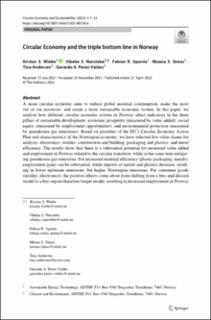| dc.contributor.author | Wiebe, Kirsten Svenja | |
| dc.contributor.author | Nørstebø, Vibeke Stærkebye | |
| dc.contributor.author | Rocha Aponte, Fabian | |
| dc.contributor.author | Silva Simas, Moana | |
| dc.contributor.author | Andersen, Tina | |
| dc.contributor.author | Valdes, Gerardo Alfredo Perez | |
| dc.date.accessioned | 2024-01-15T11:42:45Z | |
| dc.date.available | 2024-01-15T11:42:45Z | |
| dc.date.created | 2023-04-25T10:03:07Z | |
| dc.date.issued | 2023 | |
| dc.identifier.citation | Circular Economy and Sustainability. 2023, 3, 1-33. | en_US |
| dc.identifier.issn | 2730-597X | |
| dc.identifier.uri | https://hdl.handle.net/11250/3111515 | |
| dc.description.abstract | A more circular economy aims to reduce global material consumption, make the most out of our resources, and create a more sustainable economic system. In this paper, we analyze how different circular economy actions in Norway affect indicators in the three pillars of sustainable development: economic prosperity (measured by value added), social equity (measured by employment opportunities), and environmental protection (measured by greenhouse gas emissions). Based on priorities of the EU’s Circular Economy Action Plan and characteristics of the Norwegian economy, we have selected five value chains for analysis: electronics; textiles; construction and building; packaging and plastics; and metal efficiency. The results show that there is a substantial potential for increased value added and employment in Norway related to the circular transition, while at the same time mitigating greenhouse gas emissions. For increased material efficiency (plastic packaging, metals), employment gains can be substantial, while imports of metals and plastics decrease, resulting in lower upstream emissions, but higher Norwegian emissions. For consumer goods (textiles, electronics), the positive effects come about from shifting from a buy-and-discard model to a buy-repair/share/use longer model, resulting in increased employment in Norway and decreased imports, which potentially leads to lower emissions, but also lower employment globally. For re-use/re-purpose and recycling of building materials, emission-intense material extraction and processing activities are replaced by more labour intense activities, but has the largest potential of decreasing emissions within Norway. | en_US |
| dc.language.iso | eng | en_US |
| dc.publisher | Springer | en_US |
| dc.rights | Navngivelse 4.0 Internasjonal | * |
| dc.rights | Navngivelse 4.0 Internasjonal | * |
| dc.rights.uri | http://creativecommons.org/licenses/by/4.0/deed.no | * |
| dc.subject | Scenarioanalyse | en_US |
| dc.subject | Scenarioanalyse | en_US |
| dc.subject | Trippelbunnlinje | en_US |
| dc.subject | Triple bottom line | en_US |
| dc.subject | Sirkulær økonomi | en_US |
| dc.subject | Circular economy | en_US |
| dc.subject | Input-Output analyse | en_US |
| dc.subject | Input-Output Analysis | en_US |
| dc.title | Circular Economy and the triple bottom line in Norway | en_US |
| dc.title.alternative | Circular Economy and the triple bottom line in Norway | en_US |
| dc.type | Peer reviewed | en_US |
| dc.type | Journal article | en_US |
| dc.description.version | publishedVersion | en_US |
| dc.rights.holder | © The Author(s). Published by Springer. | en_US |
| dc.subject.nsi | VDP::Samfunnsøkonomi: 212 | en_US |
| dc.subject.nsi | VDP::Economics: 212 | en_US |
| dc.source.pagenumber | 1-33 | en_US |
| dc.source.volume | 3 | en_US |
| dc.source.journal | Circular Economy and Sustainability | en_US |
| dc.source.issue | 1 | en_US |
| dc.identifier.doi | 10.1007/s43615-021-00138-6 | |
| dc.identifier.cristin | 2143109 | |
| cristin.ispublished | true | |
| cristin.fulltext | original | |
| cristin.qualitycode | 1 | |

